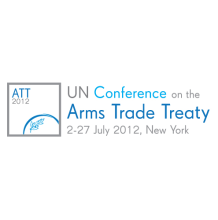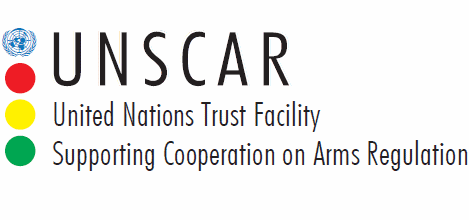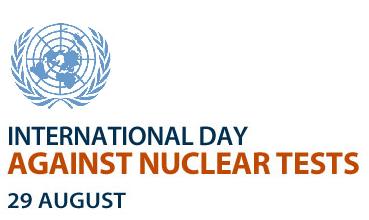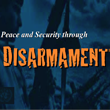Presentations

"The world is over-armed and peace is under-funded."
Secretary-General BAN Ki-moon has been an unwavering advocate for disarmament. The above quote comes from a speech he gave in 2009 in Mexico City at the 62nd annual United Nations Department of Public Information conference with NGOs. It is also the title of his recent opinion piece which appeared in news journals around the world. The slides that follow are a collection of quotes from the Secretary-General on nuclear disarmament and non-proliferation, responsible transfers of conventional weapons, military spending, the role of civil society in disarmament, illicit trafficking in small arms, and the role of women in achieving sustainable peace and security.
Go to slide show
Ammunition Stockpiles and the UN SaferGuard Programme
The problems arising from the accumulation of conventional ammunition stockpiles in surplus are of great concern to the international community. The magnitude of the problem is illustrated by the frequency of accidental explosive events in ammunition depots worldwide. These explosions invariably result in the loss of many lives, particularly where depots are located in or near urban areas.
Go to slide show
Combatting the Illicit Trade in Small Arms
Most present-day conflicts are fought with small arms and light weapons. They are the weapons of choice in civil wars and for terrorism, organized crime and gang warfare. Illicit small arms have a negative impact on security, contribute to the displacement of civilians, facilitate the violation of human rights and hamper social and economic development.
Go to slide show
Opening for Signature of the Arms Trade Treaty
On 3 June 2013, the first international treaty regulating the global arms trade in conventional arms opened for signature at UN Headquarters. The Arms Trade Treaty (ATT), which was approved overwhelmingly by the General Assembly two months ago, will come into force 90 days after it has been ratified by 50 nations.
Go to slide show
UN Conference on the Arms Trade Treaty
Repairing the damage caused by crime, gang violence or piracy - often fueled by reckless arms and ammunition transfers - vastly exceeds the initial financial profits of selling weapons. United Nations Peacekeeping alone costs the world $7 billion per year, and the global annual burden of armed violence stands at $400 billion. Without adequate regulation of international arms transfers and high common standards to guide national export decisions, the human tolls and financial costs will remain colossal.
Go to slide show
Advisory Board on Disarmament Matters
The Advisory Board on Disarmament Matters was established in 1978 after the General Assembly's first Special Session on Disarmament. It's role is to advise the Secretary-General on matters within the area of arms limitation and disarmament, to serve as the Board of Trustees of the United Nations Institute for Disarmament Research (UNIDIR), and to advise the Secretary-General on the implementation of the United Nations Disarmament Information Programme.
Go to slide show
United Nations Trust Facility Supporting Cooperation on Arms Regulation (UNSCAR)
On 7 June 2013, the United Nations Office for Disarmament Affairs launched the multi-donor United Nations Trust Facility Supporting Cooperation on Arms Regulation (UNSCAR). UNSCAR will work closely with complementary international assistance initiatives to ensure better coordination, coherence and information sharing.
Go to slide show
Military Spending
Governments around the world are spending a staggering amount of resources on their military. Global military expenditures have roughly doubled in the past decade to $1.6 trillion in 2010. That is more than ten times what is spent on official development assistance ($141 billion), and it dwarfs the regular budget of the United Nations ($2.7 billion). Less than 4 percent of annual military expenditures would be enough to achieve the Millennium Development Goals, lifting all people out of poverty.
Go to slide show
Biological Weapons Convention
The BWC, the first multilateral disarmament treaty banning the production and use of an entire category of weapons, entered into force on 26 March 1975. Over the intervening years, increasing numbers of States joined the Convention, which currently has 165 States Parties. The BWC effectively prohibits the development, production, acquisition, transfer, stockpiling and use of biological and toxin weapons and is a key element in the international community's efforts to address the proliferation of weapons of mass destruction.
Go to slide show
Focus on Armed Violence
Armed violence — the intentional, threatened or actual use of arms to inflict death or injury — takes many forms, ranging from political to criminal to interpersonal violence. According to the Global Burden of Armed Violence report, "more than 740,000 people die each year as a result of the violence associated with armed conflicts and large – and small-scale criminality. The majority of these deaths occur outside war zones."
Go to slide show
Transparency in the Global Arms Trade
After the United Nations was founded, the Cold War prevented progress in military transparency. But the flaring up of conflict in the late 1980s reignited widespread concern about the excessive build-ups of weaponry. In 1991, the General Assembly established a Register of Conventional Arms and called upon all Member States to provide annually data on their arms transfers as well as background information on military holdings and domestic arms purchases.
Go to slide show
United Nations General Assembly: Focus on Disarmament
The General Assembly (GA) of the United Nations held its first session in 1946, and has convened annual sessions every year since then. The GA is one of the five principal organs of the United Nations and the only one in which all Member States have equal representation. The very first resolution adopted by the GA in 1946 identified the goal of eliminating atomic weapons and all other major weapons adaptable to mass destruction from national armaments.
Go to slide show
Convention on Cluster Munitions
The Convention on Cluster Munitions (CCM) prohibits all use, stockpiling, production and transfer of Cluster Munitions. The CCM was adopted in Dublin on 30 May 2008. It has 108 signatories. The Convention became binding international law when it entered into force on 1 August 2010 after 30 States had ratified it. As of September 2011, 60 States have ratified the CCM and future States Parties will accede to the Convention by submitting their ratifications to the United Nations.
Go to slide show
International Day Against Nuclear Tests
The International Day against Nuclear Tests is meant to galvanize the efforts of the United Nations, Member States, intergovernmental and non-governmental organizations, academic institutions, youth networks and the media in informing, educating and advocating the necessity of banning nuclear tests as a valuable step toward achieving a safer world.
Go to slide show
Hibakusha - Atomic Bomb Survivors
The "hibakusha" are the surviving victims of the atomic bombs which fell on Hiroshima and Nagasaki. While these individuals survived the immediate effects of the blasts, the hibakusha have suffered from the effects of radiation sickness, loss of family and friends, and discrimination.
Go to slide show
50th Aniversary of the Entry into Force of the Antarctic Treaty
The Antarctic Treaty establishes Antarctica as a scientific preserve, banning military activity on the continent. The Antarctic is one of nine internationally recognized Nuclear-Weapon-Free Zones, which include Latin America and the Caribbean, the South Pacific, Southeast Asia, Africa, Central Asia, Mongolia, the seabed, and outer space.
Go to slide show
The Permanent Disarmament Collection at the United Nations
A slideshow presenting the permanent disarmament collection, which is one of the highlights of the guided tour of the United Nations Headquarters in New York City.
Go to slide show
Disarmament Treaties Timeline
The web-based Disarmament Treaties Timeline provides highlights of key events in the development of disarmament and non-proliferation international agreements as well as a brief history of how DNP issues have evolved since the creation of the UN. Browse the timeline to learn about important disarmament and non-proliferation milestones from 1946 to the present.
Go to slide show
Peace and Security Through Disarmament
This PowerPoint presentation provides a general view of disarmament by highlighting a broad range of multilateral disarmament issues and initiatives undertaken by the international community. It includes a timeline of arms regulation treaties and a map of agreed nuclear-weapons free zones. The presentation shows the imbalance between global expenditures on military and resources devoted to social and environmental global problems.
Download PPS